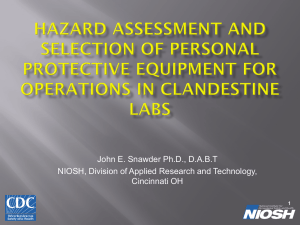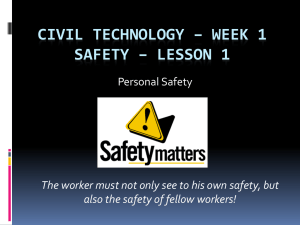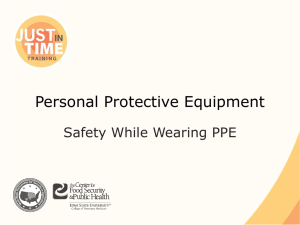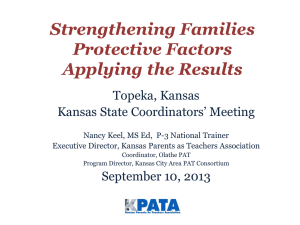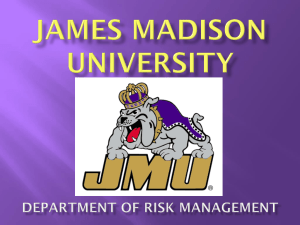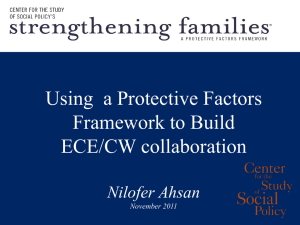PERSONAL PROTECTIVE EQUIPMENT
advertisement
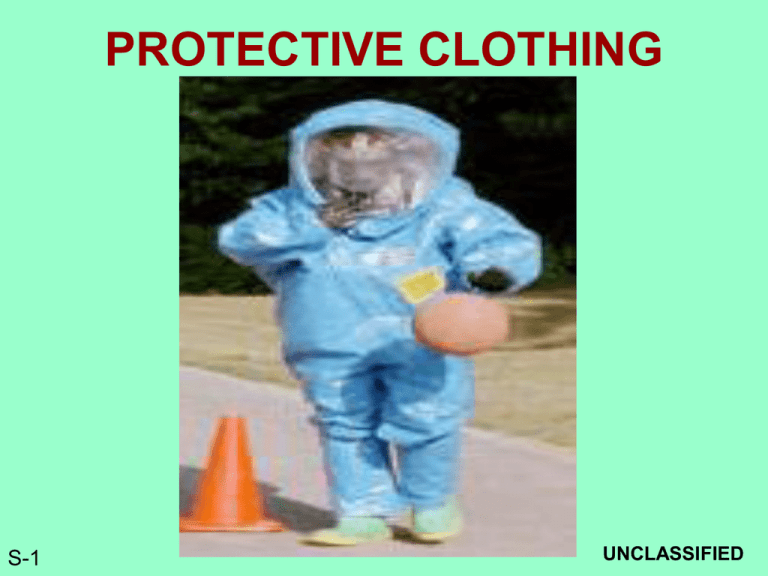
PROTECTIVE CLOTHING S-1 UNCLASSIFIED Terminal Learning Objective • Action: Select Appropriate Chemical Protective Clothing • Conditions: Given a classroom presentation and appropriate chemical protective clothing • Standard: IAW 29 CFR 1910.120 Appendix B Personal Protective Equipment (PPE) S-2 Enabling Learning Objective • Identify the requirements for selecting chemical protective clothing • Identify the two styles of chemical protective clothing • Identify the two types of suit material • Describe the different levels of Personal Protective Equipment (PPE) – Safety Requirements – Heat / Hydration – Risk Assessment Level – Medium – Environmental Assessment - None S-3 Selecting Chemical Protective Clothing >Known vs. Unknown >Work function >Work location > Weather conditions > Chemical hazard recognition > Concentration/exposure guidelines S-4 Performance Requirements • Chemical Resistance • Durability • Flexibility • Temperature Resistance S-5 • • • • • • Service life Cleanability Design Size Color Cost Style of Protective Clothing >Encapsulating S-6 >Non-encapsulating Protective Material • Elastomer - Polymeric materials that return to their original shape after being stretched. – Natural Rubber, Polyvinyl Alcohol, Chlorinated Polyethylene, Nitrile Rubber, Polyvinyl Chloride, Neoprene, Butyl Rubber, Viton, Teflon, and Polyurethane. • Non-elastomer - materials that do not have the quality of strechability. – Tyvek, Polyethylene (coated tyvek), and Saranex (laminated tyvek). S-7 Suit Configurations >Type I S-8 >Type II >Type III Resistance Factors >Penetration – defined as the bulk flow of a chemical through the protective material. >Permeation – the diffusion of a chemical on a molecular basis through chemical protective clothing. >Degradation – a change in the physical properties of the material as a result of adverse effects of the chemical. S-9 Resistance Factors >Breakthrough Time – the time it takes the chemical to pass through the protective material until it is first detected by an analytical instrument. >Permeation Rate – the mass flux (rate in mass per unit area per unit time) of the chemical through the protective material once it has broken through. S-10 Check on Learning S-11 What are the two styles of chemical protective clothing? >Encapsulating S-12 >Non-encapsulating Levels of Personal Protective Equipment (PPE) S-13 Level A Level B Level C Level D S-14 Level A > Substance has been identified and requires the highest level of protection. > Work involves a high potential for splash or exposure to skin hazards. > IDLH environment exists. S-15 Level A > Worn when the highest level of respiratory, skin, and eye protection is required. > Conditions are unknown. > Operations are conducted in confined, poorly ventilated areas. S-16 Level A - To be selected when the greatest level of skin, respiratory, and eye protection is required. 1. Positive pressure, full face-piece self-contained breathing apparatus (SCBA), or positive pressure supplied air respirator with escape SCBA, approved by the National Institute for Occupational Safety and Health (NIOSH). 2. Totally-encapsulating chemical-protective suit. 3. Coveralls.(1) 4. Long underwear.(1) 5. Gloves, outer, chemical-resistant. 6. Gloves, inner, chemical-resistant. 7. Boots, chemical-resistant, steel toe and shank. 8. Hard hat (under suit).(1) 9. Disposable protective suit, gloves and boots (depending on suit construction, may be worn over totally-encapsulating suit) Footnote(1) Optional, as applicable. S-17 Level B > Worn when the highest level of respiratory protection is needed and some degree of skin protection is required. > Presence of incompletely identified vapors or gases. > Atmosphere contains less than 19.5% oxygen. S-18 Level B Direct skin contact with the contaminant is unlikely. Involves atmospheres with IDLH concentrations, but vapors and gases do not represent a severe skin hazard. S-19 Level B - The highest level of respiratory protection is necessary but a lesser level of skin protection is needed. 1. Positive pressure, full-facepiece self-contained breathing apparatus (SCBA), or positive pressure supplied air respirator with escape SCBA (NIOSH approved). 2. Hooded chemical-resistant clothing (overalls and long-sleeved jacket; coveralls; one or two-piece chemical-splash suit; disposable chemical-resistant overalls). 3. Coveralls.(1) 4. Gloves, outer, chemical-resistant. 5. Gloves, inner, chemical-resistant. 6. Boots, outer, chemical-resistant steel toe and shank. 7. Boot-covers, outer, chemical-resistant (disposable).(1) 8. Hard hat.(1) 9. [Reserved] 10. Face shield.(1) Footnote(1) Optional, as applicable. S-20 Level C > Selected when the type of airborne contaminant is known. > Concentration level of the contaminant has been measured. > Criteria for using air-purifying respirators are met. > Severe skin hazard unlikely. S-21 Level C - The concentration(s) and type(s) of airborne substance(s) is known and the criteria for using air purifying respirators are met. 1. Full-face or half-mask, air purifying respirators (NIOSH approved). 2. Hooded chemical-resistant clothing (overalls; two-piece chemical-splash suit; disposable chemical-resistant overalls). 3. Coveralls.(1) 4. Gloves, outer, chemical-resistant. 5. Gloves, inner, chemical-resistant. 6. Boots (outer), chemical-resistant steel toe and shank. 7. Boot-covers, outer, chemical-resistant (disposable).(1) 8. Hard hat.(1) 9. Escape mask.(1) 10. Face shield.(1) Footnote(1) Optional, as applicable. S-22 Level D > Provides minimal protection from physical hazards. > Hazardous free atmosphere. > Work function precludes the potential for unexpected exposure to hazardous substances. S-23 Level D - A work uniform affording minimal protection, used for nuisance contamination only. 1. Coveralls. 2. Gloves.(1) 3. Boots/shoes, chemical-resistant steel toe and shank. 4. Boots, outer, chemical-resistant 5. Safety glasses or chemical splash goggles. 6. Hard hat.(1) 7. Escape mask.(1) 8. Face shield.(1) Footnote(1) Optional, as applicable. S-24 Check on Learning S-25 Summary • Terminal Learning Objective (TLO) • Enabling Learning Objectives (ELO’s) • Questions S-26
